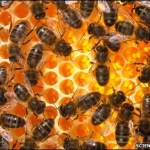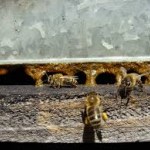hive
Varroa mites can be highly destructive to bee colonies and are a big concern for beekeepers. They get inside honeycombs where they lay eggs and feed on the bee pupae. When the adult bees are released from their cells, so are the mites, which then go on to lay more eggs. Bees that live with these mites are usually smaller and prone to a disease known as deformed wing virus. The presence of the mites and the disease can decimate an entire hive.
Image of Varroa mite on a honeybee from Wikipedia
Dr. Francis Ratnieks (University of Sussex, Brighton) observed 42 honeybee colonies and discovered…
Image from APiS UK
Propolis is a resin-like compound honeybees collect to coat their hives. New research suggests that this compound may increase hair growth as observed in studies of mice. Although the researchers did not test propolis on balding mice, they did find faster hair growth in mice that had been shaved or waxed, which is somewhat promising.
Source:
Miyata S, Oda Y, Matsuo C, et al. Stimulatory Effect of Brazilian Propolis on Hair Growth through Proliferation of Keratinocytes in Mice.J. Agric. Food Chem. 2014.
Researchers in Florida poured a liquid plaster-metal mixture into the nests of the Florida harvester ant. The resulting casts display astonishing intricacy and depth. One interesting discovery was that the top heavy nature of the chambers reflects age distribution within the any colony and not necessarily earlier digging. Younger ants tend to dig within the bottom 2/3rds of the nest while older ants dig in the top 1/3rd, eventually graduating to harvesting outside of the nest. The highest concentration of ants, therefore, is in the top of the nests, resulting in more chambers.Although this…

